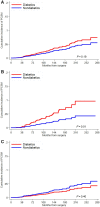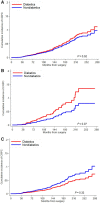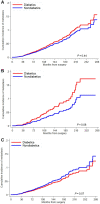Diabetes and Prostate Cancer Outcomes in Obese and Nonobese Men After Radical Prostatectomy
- PMID: 34169227
- PMCID: PMC8220304
- DOI: 10.1093/jncics/pkab023
Diabetes and Prostate Cancer Outcomes in Obese and Nonobese Men After Radical Prostatectomy
Abstract
Background: The link between diabetes and prostate cancer progression is poorly understood and complicated by obesity. We investigated associations between diabetes and prostate cancer-specific mortality (PCSM), castrate-resistant prostate cancer (CRPC), and metastases in obese and nonobese men undergoing radical prostatectomy (RP).
Methods: We included 4688 men from the Shared Equal Access Regional Cancer Hospital cohort of men undergoing RP from 1988 to 2017. Diabetes prior to RP, anthropometric, and clinical data were abstracted from 6 Veterans Affairs Medical Centers electronic medical records. Primary and secondary outcomes were PCSM and metastases and CRPC, respectively. Multivariable-adjusted hazard ratios (adj-HRs) and 95% confidence intervals (CIs) were estimated for diabetes and PCSM, CRPC, and metastases. Adjusted hazard ratios were also estimated in analyses stratified by obesity (body mass index: nonobese <30 kg/m2; obese ≥30 kg/m2). All statistical tests were 2-sided.
Results: Diabetes was not associated with PCSM (adj-HR = 1.38, 95% CI = 0.86 to 2.24), CRPC (adj-HR = 1.05, 95% CI = 0.67 to 1.64), or metastases (adj-HR = 1.01, 95% CI = 0.70 to 1.46), among all men. Interaction terms for diabetes and obesity were statistically significant in multivariable models for PCSM, CRPC, and metastases (P ≤ .04). In stratified analyses, in obese men, diabetes was associated with PCSM (adj-HR = 3.06, 95% CI = 1.40 to 6.69), CRPC (adj-HR = 2.14, 95% CI = 1.11 to 4.15), and metastases (adj-HR = 1.57, 95% CI = 0.88 to 2.78), though not statistically significant for metastases. In nonobese men, inverse associations were suggested for diabetes and prostate cancer outcomes without reaching statistical significance.
Conclusions: Diabetes was associated with increased risks of prostate cancer progression and mortality among obese men but not among nonobese men, highlighting the importance of aggressively curtailing the increasing prevalence of obesity in prostate cancer survivors.
© The Author(s) 2021. Published by Oxford University Press.
Figures




Comment in
-
Urological Oncology: Prostate Cancer.J Urol. 2022 May;207(5):1155-1156. doi: 10.1097/JU.0000000000002477. Epub 2022 Feb 16. J Urol. 2022. PMID: 35168364 No abstract available.
References
-
- Pierce BL. Why are diabetics at reduced risk for prostate cancer? A review of the epidemiologic evidence. Urol Oncol. 2012;30(5):735–743. - PubMed
-
- Vigneri P, Frasca F, Sciacca L, et al.Diabetes and cancer. Endocr Relat Cancer. 2009;16(4):1103–1123. - PubMed
-
- Tsilidis KK, Allen NE, Appleby PN, et al.Diabetes mellitus and risk of prostate cancer in the European Prospective Investigation into Cancer and Nutrition. Int J Cancer. 2015;136(2):372–381. - PubMed
-
- Gong Z, Neuhouser ML, Goodman PJ, et al.Obesity, diabetes, and risk of prostate cancer: results from the prostate cancer prevention trial. Cancer Epidemiol Biomarkers Prev. 2006;15(10):1977–1983. - PubMed
